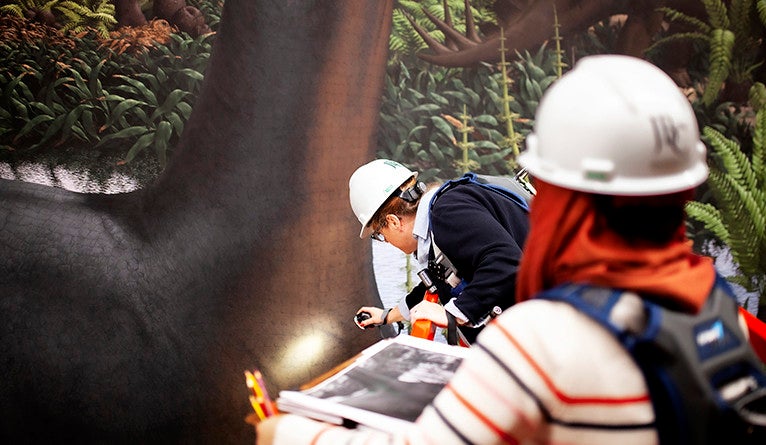Peabody’s iconic dinosaur mural gets check up ahead of museum renovation

Art conservators assess the condition of “The Age of Reptiles,” Rudolph F. Zallinger’s iconic mural depicting dinosaur species over a span of 362 million years, ahead of the museum’s upcoming renovation.
“The Age of Reptiles” — the Yale Peabody Museum of Natural History’s iconic panoramic mural depicting the lives and times of dinosaurs and other reptiles — is being prepped for what you might call the museum’s fast-approaching Age of Renovation.
Art conservators recently boarded a scissor lift in the museum’s Great Hall and rose to a height about level with the nearby Brontosaurus skeleton’s skull to assess the state of artist Rudolph F. Zallinger’s 1947 masterpiece, which has awed generations of visitors with its panoply of dinosaur species roaming in a lush, volcano-dotted landscape. The assessment is necessary to prepare the mural for the Peabody Museum’s upcoming major renovation, expected to start in December 2020 and take two years.
The museum will close for the renovation, but the 110-foot-long, 16-foot-high mural will remain in place.
“We’re assessing the mural’s condition today to see if there’s anything we need to do to stabilize it before the renovation begins,” said Mariana Di Giacomo, the museum’s natural history conservator. “Construction will produce dust and vibrations. We need a record of the painting’s current condition so that we can effectively monitor it as the work progresses.”
Zallinger ’42 B.F.A. ’71 M.F.A. painted the prehistoric scene directly onto dry plaster along the Great Hall’s east wall — a wall-painting technique called fresco-secco that was in fashion during the Renaissance. As a result, the mural cannot be moved and must be protected and monitored throughout the renovation.

The mural will be sheltered behind scaffolding during construction, Di Giacomo explained, adding that he protective barrier won’t touch the painting’s surface and that air will circulate behind it to prevent mold. Devices will continually monitor vibrations, and there will be frequent site visits to evaluate the mural’s condition, she said.
Zallinger spent more than four years painting “The Age of Reptiles,” which depicts 32 dinosaur species spanning 362 million years. It begins with the origin of land vertebrates during the Devonian Period and ends with the dinosaurs’ extinction during the Cretaceous era.
The work earned Zallinger the 1949 Pulitzer Fellowship in Art. In 1953, Life magazine published the entire painting in a foldout. The T. rex commanding the mural’s left side influenced the design of Godzilla, the atomic-powered sea monster that made its motion picture debut in 1954.
While the mural’s portrayal of dinosaurs and plant life are scientifically outdated, it remains a captivating work of art that represents human understanding of dinosaurs as of the 1940s, Di Giacomo said.
“It’s a fascinating mural because it depicts an extremely long history of time in a confined amount of space, and it is interesting to see how people understood dinosaurs at the time,” she said. “It’s not only beautiful, but it inspires learning, and can spark conversations about how our scientific understanding of things evolves.”
The conservators, who work for New York City-based Jablonski Building Conservation, photographed the mural to document its condition before inspecting it for areas of instability, such as flaking paint.
“If they discover any area that is really delicate, we will stabilize it ahead of construction,” Di Giacomo said. “If there are areas of fading or paint loss, we will wait until after the renovation to treat them.”

The mural was fully restored about a decade ago, and Di Giacomo said she doubts the assessment will reveal any serious problems.
Zallinger’s “The Age of Mammals,” overlooking the museum’s Hall of Mammalian Evolution, is also being assessed. Painted in 1964, the 60-foot long and 5.5-foot high mural portrays an array of mammal species that inhabited western North America beginning more than 65 million years ago. The painted landscapes of the museum’s prized North American and Southern New England dioramas also will be documented and inspected, and, if needed, stabilized.
The Great Hall closes to the public on Dec. 31 and the fossil exhibits will be removed beginning Jan. 2. The showpiece skeletons, including the Brontosaurus and Stegosaurus, will be shipped to Research Casting International, an Ontario-based firm that specializes in mounting and restoring museum fossil specimens. There they will be remounted into more natural and scientifically accurate poses. Other specimens will be moved to the museum’s collections facility at Yale’s West Campus for remounting.
The museum, located at 170 Whitney Ave. in New Haven, will close to the public in July 2020. It is scheduled to open in 2023.
Related
Media Contact
Bess Connolly : elizabeth.connolly@yale.edu,